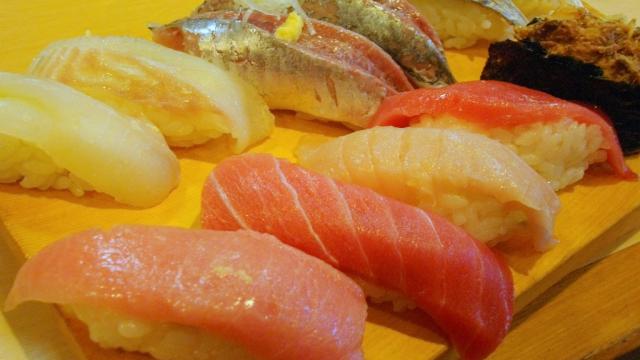If you like sushi, there’s one man given credit for the creation of the iconic Japanese meal as we now know it. His name is Yohei Hanaya.
Certainly, there are several different kinds of sushi. Hanaya, however, is called the father of “nigiri-zushi” or the “hand-pressed” type of sushi. When people think of sushi, they typically imagine nigiri-zushi. Like this:
[Photo: Jpatokal]
Sushi itself has its roots in a dish imported during from ancient China, in which fish was salted and then wrapped with fermented rice to keep it from going bad. The fish could be preserved for months and when eaten, the fermented rice was pitched.
However, by the Edo Period (1603-1868), Japan had its own special spin on this meal by creating a type of sushi, known as haya-zushi, that was made so that the fish and the rice were eaten at the same time.
[Photo: edococo]
During the 18th century, Edo (present day Tokyo) experienced a boom in food stalls, which were akin to modern fast food restaurants. As part of the expanding take-out menu, nigiri-zushi was invented, appearing during the first quarter of the 19th century.
Yohei Hanaya (1799 to 1858) gets credit as nigiri zushi’s inventor — even Japan’s largest vinegar maker, Mizkan, calls him the “father” of sushi. (Though, as Nihombashi Tokyo points out, there were other nigiri-zushi chefs at that time.) After selling his sushi at street stalls, Hanaya established his own restaurant, known as “Yohei’s Sushi,” that specialised in hand-pressed sushi.
Here are images of the sushi chef and his restaurant. A placard now marks the spot in Tokyo where Hanaya’s nigiri-zushi was born.
As The History of Nihonbashi Uogashi explains, during the early 19th century, Japanese people did not hold tuna in high regard. Today, of course, tuna (or maguro) is one of the most important fishes found in sushi. Since the fish was plentiful, Hanaya served it up, preparing it with soy sauce and helping kick off a tuna craze in Edo.
The visual beauty of nigiri-zushi, combined with its freshness and quick prep time, made it a hit. Hanaya’s sushi was close to what you’d find today. For example, besides hand-pressing the sushi, he also used a dab of wasabi and vinegared rice — practices that continues. This article’s lede image is a 1877 drawing of Hanaya’s famous sushi. You can still find many of these types of nigiri-zushi at restaurants in Japan.
And like today, Hanaya’s sushi was popular with children. (Generally speaking, Japanese children love eating curry, sushi, and grilled beef. Not at the same time, mind you.)
[Photo: Tokyo Metropolitan Library]
Hanaya’s sushi was so popular that soon others began borrowing his creation. Today, it’s not uncommon for inventive dishes to be copied by the competition. Take the cronut, for example. Heh.
While Hanaya is credited with one of Japan’s most iconic meals, the government didn’t initially recognise him or his creation.
[Photo: Hiroshige]
As Mizkan explains, there was a famine in Edo in 1833, which led to the Tempo Reforms (1841-1843) that cracked down on luxury items. It’s said that Hanaya and hundreds of other sushi chefs were arrested, as sushi violated the sumptuary laws of the day. The reforms failed, the sumptuary laws were no longer enforced, and sushi resumed its spread across Japan.
Today, Yohei Hanaya lives on through nigiri-zushi, Japan’s most famous raw fish dish. There’s even a restaurant chain that took his name. It serves noodles, soup, and, of course, sushi.
[Photo: Zensho]
Kotaku East is your slice of Asian internet culture, bringing you the latest talking points from Japan, Korea, China and beyond. Tune in every morning from 4am to 8am.

Comments
3 responses to “The Man Who Invented Sushi”
i dont think you can invent raw fish
or play games on
You are getting sushi and sashimi mixed up. Raw fish on its own is sashimi.
relates to gaming and gaming culture how exactly?
Japan = Videogames
And my son and all his 6-7 yr old mates all love the stuff. Won’t touch junk food of any kind, but Sushi? Bring it
Sushi is not raw fish. Sushi literally means “vinegar-ed”, which if you cut the fish thin enough (like it should correctly be) the vinegar in the rice begins to cook the fish. The cooking process is finished when the heat in your mouth seals the cooking deal. That’s the difference between real sushi and that fast food sushi crap you get from an untrained sushi preparer who doesn’t know what they are doing.